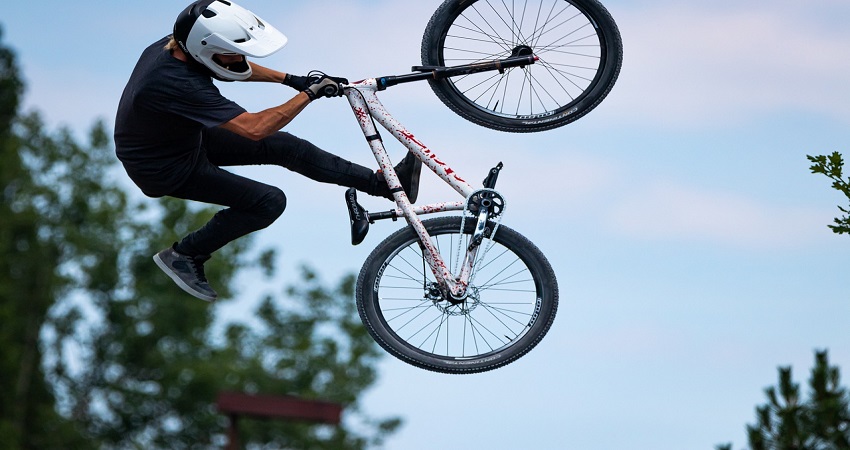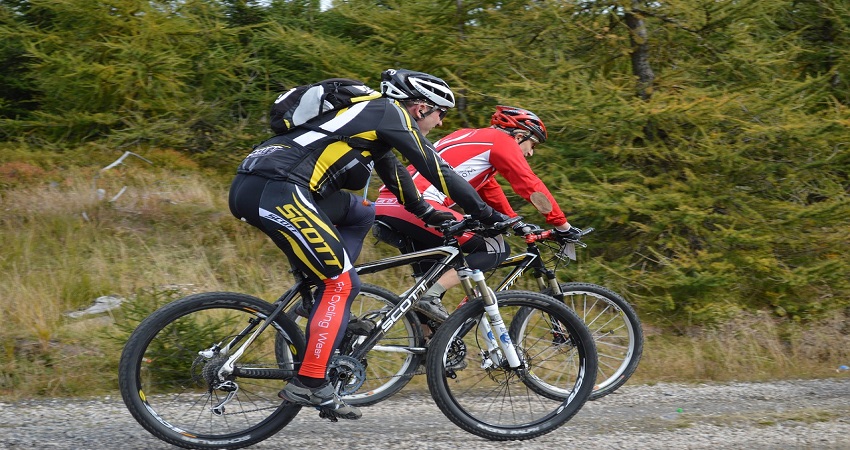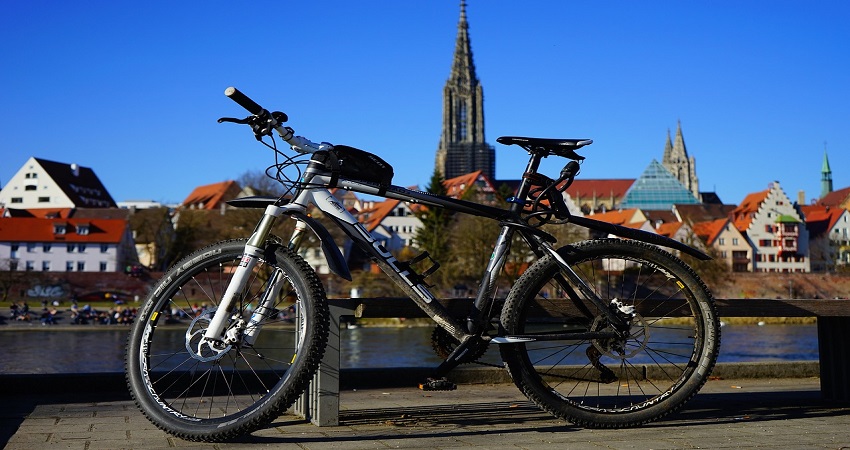Mountain bikes are categorized into cross-country, trail, enduro, and downhill bikes. These types of mountain bikes serve specific riding disciplines and terrain conditions.
Cross-country bikes are designed for long-distance rides, while trail bikes are versatile for various terrains. Enduro bikes are built for aggressive descents, and downhill bikes excel in steep, rugged descents. When it comes to choosing a mountain bike, understanding the different types is crucial.
Each type is tailored to specific terrains and disciplines, providing riders with different features and capabilities. Whether you are a beginner or an experienced rider, knowing the distinct characteristics of each type can help you make an informed decision.
Mountain biking offers an exhilarating outdoor experience, and the right type of bike can enhance your enjoyment and performance.
In this guide, we will explore the various types of mountain bikes, helping you understand each type’s strengths and purposes. Whether you prefer tackling challenging trails or clocking miles in cross-country races, selecting the right mountain bike is essential for an enjoyable and safe riding experience.
Hardtail Vs. Full-suspension
When it comes to choosing a mountain bike, one of the key decisions to make is whether to opt for a hardtail or a full-suspension bike. Understanding the differences between these two types can help you make an informed decision based on your riding style and preferences.
Comparison Of Features
| Features | Hardtail | Full-Suspension |
|---|---|---|
| Shock Absorption | Front-only | Front and rear |
| Weight | Lighter | Heavier |
| Cost | More affordable | Higher price point |
| Stability | Enhanced on smooth terrains | Improved on rough terrains |
Pros And Cons Of Each Type
- Hardtail: Offers a lightweight and cost-effective option, ideal for smooth terrains and efficient climbing. However, it may provide less stability and shock absorption on rough trails.
- Full-Suspension: Provides superior shock absorption, offering a smoother ride on uneven terrains, and increased stability. However, it tends to be heavier and comes with a higher price tag.
Cross-country Bikes
Cross-country bikes are one of the various types of mountain bikes, designed for long-distance rides on off-road trails and terrains. These bikes are lightweight, have a narrower frame, and efficient climbing capabilities, making them ideal for endurance and speed-focused riders.
Design And Features Of Cross-country Bikes
Cross-country bikes are specifically designed to excel in endurance races and long-distance trails. They are known for their lightweight construction and efficient pedaling capabilities. These bikes are built with agility and speed in mind, enabling riders to navigate through technical terrains with ease.
To ensure optimal performance, cross-country bikes have a unique design and various features that set them apart from other mountain bikes. Here are some key design elements and features to consider:
1. Frame:
The frame of a cross-country bike is typically made from lightweight materials such as carbon fiber or aluminum. This allows riders to have better control and maneuverability on the trails while minimizing unnecessary weight.
2. Suspension:
Cross-country bikes typically come with a suspension fork at the front to absorb shock and provide comfort during rough rides. However, the rear suspension is often kept minimal or eliminated entirely, making these bikes known as “hardtail” bikes. This design choice reduces weight and maximizes pedaling efficiency.
3. Tire Size:
Cross-country bikes usually feature narrower tires compared to other mountain bikes. The tire width is designed to strike a balance between rolling resistance and grip on a variety of terrains, allowing riders to maintain momentum while still maintaining control.
4. Gearing:
Cross-country bikes are equipped with a wide range of gears to tackle steep climbs and fast descents. The gearing system enables riders to efficiently switch between different speeds and maintain a steady cadence throughout their ride.
Ideal Terrain For Cross-country Biking
Cross-country biking is all about covering long distances and conquering challenging terrain. Here are some ideal terrains where cross-country bikes can thrive:
1. Cross-Country Trails:
As the name suggests, cross-country bikes are perfectly suited for cross-country trails. These trails often feature a mix of uphill climbs, technical descents, and flat sections. Cross-country bikes excel in handling a variety of terrains, making them a popular choice for this type of trail.
2. Singletrack:
Singletrack trails are narrow and winding, requiring precise handling and maneuverability. Cross-country bikes, with their lightweight and nimble design, are well-suited for navigating through these tight trails with ease.
3. Uphill Climbs:
One of the strengths of cross-country bikes is their efficiency in climbing uphill. The lightweight frame and efficient pedaling system allow riders to tackle steep inclines with less effort, making them an ideal choice for hilly terrains.
4. Multi-Day Endurance Races:
Cross-country bikes are designed for endurance and long-distance riding, making them perfect for multi-day racing events. These bikes are sturdy enough to withstand the demands of prolonged use while still providing comfort for the rider.
In conclusion, cross-country bikes are purpose-built for endurance races and long-distance trail riding. Their lightweight construction, efficient pedaling capabilities, and nimble design make them ideal for tackling a variety of terrains.
Whether you’re a competitive racer or an adventure seeker, cross-country bikes offer the agility and performance needed to conquer challenging trails and achieve your cycling goals.
Trail Bikes
Trail bikes are one of the main types of mountain bikes, perfect for diverse terrains with a focus on uphill and downhill riding. Popular among beginners, trail bikes offer a balance between technical challenges and cross-country adventures.
Characteristics Of Trail Bikes
Trail bikes are a popular type of mountain bike that is designed for a variety of terrains, making them versatile and suitable for different riding styles. They are designed to handle both uphill and downhill trails, striking a balance between climbing ability and descending skills.
Here are some key characteristics of trail bikes:
- Lightweight: Trail bikes are often built with lightweight materials such as aluminum or carbon fiber to make them agile and responsive on the trails.
- Suspension System: They feature a full suspension system, with both front and rear suspension, to absorb shocks and bumps on rough terrains. This provides the rider with a smoother and more comfortable ride.
- Moderate Travel: Trail bikes typically have a moderate amount of suspension travel, ranging from 120mm to 150mm. This allows them to handle a wide range of trails, from smooth and flowy to rough and technical.
- Geometry: Trail bikes have a balanced geometry that strikes a compromise between stability and maneuverability. They usually have a slightly slacker head angle and a longer wheelbase compared to cross-country bikes, which enhances stability at high speeds.
Benefits Of Using Trail Bikes
Trail bikes offer several benefits that make them a popular choice for mountain bikers of all skill levels. Whether you are a beginner or an experienced rider, here are some advantages of using trail bikes:
- Versatility: Trail bikes are designed to handle a wide range of terrains, making them suitable for various riding styles. They can tackle technical descents, steep climbs, and everything in between.
- Comfort: With their full suspension system, trail bikes provide a smoother and more comfortable ride by absorbing the impact of rough trails. This allows riders to enjoy longer rides without experiencing excessive fatigue.
- Control and Stability: The balanced geometry of trail bikes offers excellent control and stability, allowing riders to navigate through challenging sections with confidence.
- Agility: Despite their stability, trail bikes are still agile enough to handle tight corners and maneuver through narrow trails. This makes them suitable for riders who enjoy more technical and twisty trails.
- Adaptability: Trail bikes can be ridden on a variety of trails, from cross country routes to more aggressive downhill tracks. This adaptability makes them a great all-around choice for riders who want to explore different types of mountain biking.
In conclusion, trail bikes are a versatile and popular type of mountain bike that offers a combination of climbing ability and descending skills.
With their lightweight construction, full suspension system, and balanced geometry, they are designed to handle a wide range of terrains and riding styles.
Whether you are a beginner or an experienced rider, trail bikes provide comfort, control, and adaptability, making them a great choice for exploring diverse trails.
Enduro Bikes
Enduro bikes are a popular type of mountain bike known for their versatility in handling both uphill and downhill terrains. With sturdy frames and responsive suspension systems, these bikes are ideal for riders tackling challenging trails and technical descents.
Attributes Of Enduro Bikes
When it comes to mountain biking, one type of bike that has gained significant popularity in recent years is the Enduro bike. Designed to handle the demands of aggressive trail riding and competitive Enduro racing, these bikes are built to excel in both uphill climbs and thrilling descents. Enduro bikes have several key attributes that set them apart from other types of mountain bikes.
These include:
- Suspension: Enduro bikes typically feature full suspension systems with longer travel than other mountain bikes. This allows them to absorb big hits and provide a smooth ride on rough and technical terrain.
- Geometry: The geometry of an Enduro bike is specifically designed to provide stability and control at high speeds. They often have slacker head angles and longer wheelbases, which enhances their downhill performance.
- Durability: Enduro bikes need to withstand the rigors of aggressive riding, so they are built with durability in mind. They often have stronger frames, reinforced components, and wider tires to handle the demands of rough trails.
- Versatility: Enduro bikes are designed to be versatile, excelling in a variety of terrains and riding conditions. They are capable climbers, thanks to efficient pedaling platforms and lightweight designs, while still maintaining exceptional downhill capabilities.
Performance In Enduro Riding
In Enduro riding, performance is key, and Enduro bikes are built to deliver. These bikes are specifically engineered to handle the demands of Enduro races, which involve timed downhill sections and challenging climbs. Here’s how Enduro bikes perform in various aspects of Enduro riding:
- Downhill Speed: With their slack geometry and long suspension travel, Enduro bikes excel in fast and technical downhill sections. They provide stability and control, allowing riders to navigate through tricky obstacles and maintain speed.
- Climbing Efficiency: Despite their downhill prowess, Enduro bikes are designed to climb efficiently, thanks to advanced suspension systems and lightweight construction. Riders can conquer steep climbs and challenging uphill sections without sacrificing too much energy.
- Technical Handling: Enduro bikes are known for their exceptional handling on technical terrain. They have precise steering and responsive suspension, allowing riders to maneuver through tight turns, rocky sections, and drop-offs with confidence.
- Trail Adaptability: Enduro bikes are versatile machines that can handle a wide range of trail conditions. They are equally at home on smooth singletrack as they are on rough and technical descents. This adaptability makes them the ideal choice for riders who enjoy exploring different types of trails.
In conclusion, Enduro bikes are purpose-built machines that combine the best aspects of climbing efficiency and downhill performance. Whether you’re a competitive Enduro racer or someone who enjoys aggressive trail riding, an Enduro bike will provide you with the capabilities you need to take on challenging terrain with confidence and style.
Downhill/freeride Bikes
Downhill/Freeride bikes are specifically designed for aggressive downhill riding and technical terrain challenges. These bikes offer exceptional durability and performance to handle steep descents and jumps with ease.
Specialized Design For Downhill Riding
- Durable Construction: Downhill bikes are built with reinforced frames and components to withstand harsh impacts and high speeds.
- Long Travel Suspension: These bikes feature long-travel suspension systems that absorb rough terrain and provide optimal control.
- Slack Geometry: The frame geometry of downhill bikes is slack, enhancing stability and handling on steep descents.
- Limited Gearing: Downhill bikes often have fewer gears, focusing on high speeds rather than climbing efficiency.
Safety Considerations
- Protective Gear: It is essential to wear proper safety gear, including a full-face helmet, body armor, and knee pads.
- Braking Technique: Mastering braking control is crucial for downhill riding to navigate steep descents safely.
- Inspect Regularly: Check the bike’s components regularly to ensure they are in optimal condition for downhill riding.
Specialty Mountain Bikes
Within the world of mountain biking, there are various specialty mountain bikes designed to cater to specific riding styles and terrains.
Overview Of Fatbikes
Fatbikes are renowned for their oversized tires that offer exceptional traction on challenging terrains such as snow, sand, and mud. These bikes provide stability and control, making them ideal for riders seeking adventurous off-road experiences.
Introduction To Freeride Bikes
Freeride bikes are built to withstand intense downhill descents and jumps, incorporating features like robust frames and suspension systems to absorb impacts. These bikes are favored by adrenaline-seeking riders who enjoy tackling rugged trails and obstacles.
Choosing The Right Mountain Bike
When it comes to choosing the right mountain bike, it’s essential to consider various factors that align with your riding style and preferences. With different types of mountain bikes available, each tailored to specific terrains and riding disciplines, understanding the key elements to match the bike type with your riding style is crucial for an enjoyable and successful mountain biking experience.
Factors To Consider
Several factors need to be considered when choosing a mountain bike. These include your riding style, the type of terrain you’ll be tackling, your skill level, and the features of the bike that best suit your needs. Considering these factors will help ensure that you select a mountain bike that is a perfect fit for your adventures.
Matching Bike Type To Riding Style
Matching the bike type to your riding style is crucial for optimal performance and enjoyment. Whether you prefer conquering challenging downhill trails, navigating technical cross-country routes, or tackling all-mountain terrains, selecting the right bike type that complements your riding style is essential for a rewarding experience.
Understanding the different bike types and their suitability to various riding styles is vital in making an informed decision.
Frequently Asked Questions
What Different Types Of Mountain Bikes Are There?
Types of mountain bikes include cross-country, trail, enduro, downhill, hardtail, full-suspension, fatbike, and freeride bikes.
What Are The Different Mountain Bike Classes?
Mountain bike classes include downhill, cross-country, slopestyle, enduro, and four-cross, catering to different riding styles and terrains.
What Are The Different Types Of Mountain Bike Frames?
There are three main types of mountain bike frames: cross-country, trail, and enduro. Choosing the right frame can be overwhelming, especially for beginners. Each frame type is designed for different terrain and riding styles. It’s important to understand the technical terms when buying or upgrading your mountain bike.
What Is The Most Popular Type Of Mountain Biking?
The most popular type of mountain biking is the trail, focusing on technical downhill and cross-country terrain.
Conclusion
Exploring the various types of mountain bikes can be an exciting journey for any rider. Whether it’s the versatility of cross-country, the adrenaline rush of downhill, or the endurance required for enduro, there is a perfect fit for every rider’s preferences.




